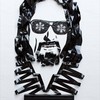What is the origin of Halloween?: originally appeared on Quora: The best answer to any question. Ask a question, get a great answer. Learn from experts and access insider knowledge. You can follow Quora on Twitter, Facebook, and Google+.
Lemuria
Following the annual harvest which fell at the end of October, the romans would celebrate or participate in Lemuria. By all accounts, Lemuria was a festival of exorcism, in which Romans would perform rituals to purge or ward evil and malevolent spirits from their homes.
Its origin derives from a myth involving Romulus appeasing Remus. The festival is strikingly different in execution, which generally involved making very loud noises using bronze kettles and demanding that spirits vacate the premises. Not entirely different from the priest in the Exorcist yelling at the demon to get out.
Festival of Samhain
For the Celts, the date was earmarked as a holiday celebrating the end of the harvest, not so different from the Romans. In these Celtic cultures, a festival was held known as Samhain. It served two main purposes: celebrating the end of a toiling few weeks of harvest and a recognition that the "light" parts of the year (Spring and Summer) were transitioning into the "dark" parts of the year (Fall and Winter).
Towards the end of the middle ages particularly in Ireland, this also marked the end of the seasons set aside of trade and warfare, making it an ideal time for parley and discussion between sovereigns.
The Gaelic festival of Samhain is where we see a lot of the customs associated with celebrating Halloween. Being the end of the harvest, this time of year also marked the time when cattle were slaughtered to provide meat for the cold months. Being a fairly nature-focused people, many of the rituals that occurred were in an effort to stave this mass slaughter of livestock. Not all of the rituals made it to the modern day celebration, such as throwing the bones of the cattle on massive bonfires; however, some are continued in one fashion or another:
- Costumes - most wore costumes during this festival. They dressed as nasty evil things in order to ward off the spirits of the dead. Its not clear whether they were attempting to dress like the spirits or not, but the purpose was certainly to ward against evil spirits.
The spirits in question here was partially attributed to Ghosts (our modern interpretation) but more so to the Sidhe (pronounced Shee). The Sidhe are better known as Faeries and embodied animistic ideology for the Celts.
All Saint's Day and All Hallow's Eve
Despite popular belief, All Saint's Day and All Hallow's Eve (Halloween's namesake) and Samhain were simultaneously occurring events for at least several hundred years. Not remarkable given the political importance of this time of year.
The rituals associated with All Saint's Day itself really had little impact on the festival celebrations of Halloween beyond giving it its name. After all, harvest time was something everyone shared; pagans and christians alike celebrated the momentous occasion.
The American/Modern Version of Halloween
It should come as no surprise that turmoil in Europe throughout the first and second millennia worked to fuse these simultaneous festivals into what it is today. For all of these cultures, it marked the end of the boisterous seasons of growth and warmth and marked the beginning of the quiet and dark times when life vacates the world and people would struggle to survive (in certain areas).
Some of the specific modern customs originated over the years and were specific to location:
- Jack-o-lanterns: The native americans and early pioneers in the United States discovered an abundance of Pumpkins! As they were generally plumply blossoming at this time of year, the art of carving them started. The purpose was still to ward evil spirits.

